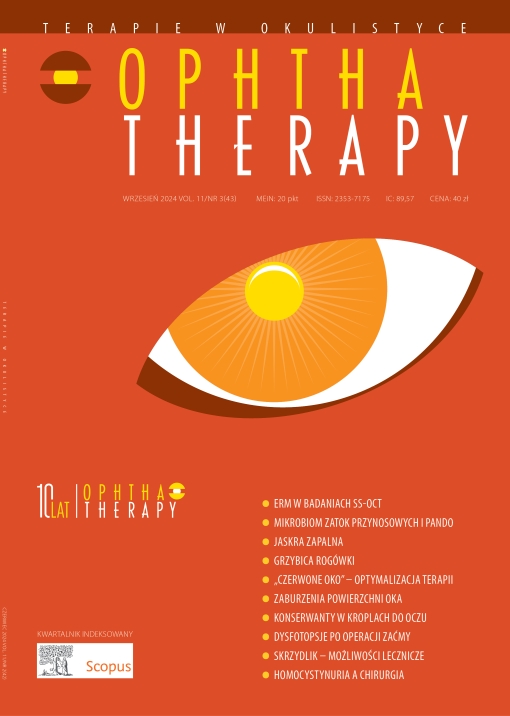Optimizing the care of the red eye patient: a new treatment direction Meeting Proceedings
Main Article Content
Abstract
Eye redness may be the result or symptom of various eye diseases or may appear for no apparent reason. In the case of red eye, therapeutic treatment is based on the correct diagnosis and, if possible, on causal treatment.
Therapeutic strategies in the treatment of local conjunctival hyperemia are also based on preventing vasodilation and thus reducing the red eye symptom.
Vasodilation is dependent on α-adrenergic receptors. Two classes of adrenergic receptors in the eye: α1- and α2 adrenergic receptors, which are responsible for the vascular tone of the conjunctiva. The end result of binding of agonists to α1- and α2-adrenergic receptors is vasoconstriction. However, the use of vasoconstrictor drugs is associated with the occurrence of tachyphylaxis, i.e. a decrease in effectiveness with long-term use and a rebound effect defined as hyperemia, which becomes even more severe after discontinuation of treatment. The introduction of brimonidine, which is a selective α2-adrenergic agonist, into the treatment resulted in a reduction of these effects, which is also due to its effect on venous vessels and not causing the symptoms of tissue hypoxia. Compared to other vasoconstrictor drugs, it offers hope for patients with red eye symptoms to improve the local condition and their quality of life.
Downloads
Article Details
Copyright: © Medical Education sp. z o.o. License allowing third parties to copy and redistribute the material in any medium or format and to remix, transform, and build upon the material, provided the original work is properly cited and states its license.
Address reprint requests to: Medical Education, Marcin Kuźma (marcin.kuzma@mededu.pl)
References
2. Bonini S. The red eye. Eur J Ophthalmol. 2021; 31(6): 2843-9. http://doi.org/10.1177/11206721211024827.
3. Hosten LO, Snyder C. Over-the-Counter Ocular Decongestants in the United States - Mechanisms of Action and Clinical Utility for Management of Ocular Redness. Clin Optom (Auckl). 2020; 12: 95-105.
4. Burke D. What You Need to Know About Eye Redness.
5. Rahman MQ, Ramaesh K, Montgomeryt DMI. Brimonidine for glaucoma Expert Opin Drug Saf. 2010; 9: 483-9.
6. Pasquali TA, Aufderheide A, Brinton JP et al. Dilute brimonidine to improve patient comfort and subconjunctival hemorrhage after LASIK. J Refract Surg. 2013; 29: 469-75.
7. McAuliffe-Curtin D, Buckley C. Review of alpha adrenoceptor function in the eye. Eye (Lond). 1989; 3: 472-6.
8. Guimarães S, Moura D. Vascular adrenoceptors: an update. Pharmacol Rev. 2001; 53(2): 319-56.
9. Greenfield DS, Liebmann JM, Ritch R.: Brimonidine: a new alpha2-adrenoreceptor agonist for glaucoma treatment J Glaucoma. 1997; 6(4): 250-8.
10. Vaajanen A. Vapaatalo H. A Single Drop in the Eye – Effects on the Whole Body. The Open Ophthalmology Journal. 2017; 11: 305-14.
11. Potter DE, Crosson CE, Heath AR et al. Review: alpha 2 and DA2 agonists as antiglaucoma agents: comparative pharmacology and clinical potential. J Ocul Pharmacol. 1990; 6(3): 251-7. http://doi.org/10.1089/jop.1990.6.251.
12. Toris CB, Gleason ML, Camras CB et al. Effects of brimonidine on aqueous humor dynamics in human eyes Arch Ophthalmol. 1995; 113: 1514-7.
13. Fowler J Jr, Jackson M, Moore A et al. Efficacy and safety of once-daily topical brimonidine tartrate gel 0.5% for the treatment of moderate to severe facial erythema of rosacea: results of two randomized, double-blind, and vehicle-controlled pivotal studies J Drugs Dermatol. 2013; 12: 650-6.
14. Melamed S, David R. Ongoing clinical assessment of the safety profile and efficacy of brimonidine compared with timolol: year-three results. Brimonidine Study Group II. Clin Ther. 2000; 22: 103-11.
15. McLaurin E, Cavet ME, Gomes PJ et al. Brimonidine Ophthalmic Solution 0.025% for Reduction of Ocular Redness: A Randomized Clinical Trial. Optom Vis Sci. 2018; 95: 264-71. http://doi.org/10.1097/OPX.0000000000001182.
16. Torkildsen GL, Sanfilippo CM, DeCory HH et al. Evaluation of Efficacy and Safety of Brimonidine Tartrate Ophthalmic Solution, 0.025% for Treatment of Ocular Redness. Curr Eye Res. 2018; 43(1): 43-51.
17. Ackerman SL, Torkildsen GL, McLaurin E et al. Low-dose brimonidine for relief of ocular redness: integrated analysis of four clinical trials. Clin Exp Optom. 2019; 102(2): 131-9.

